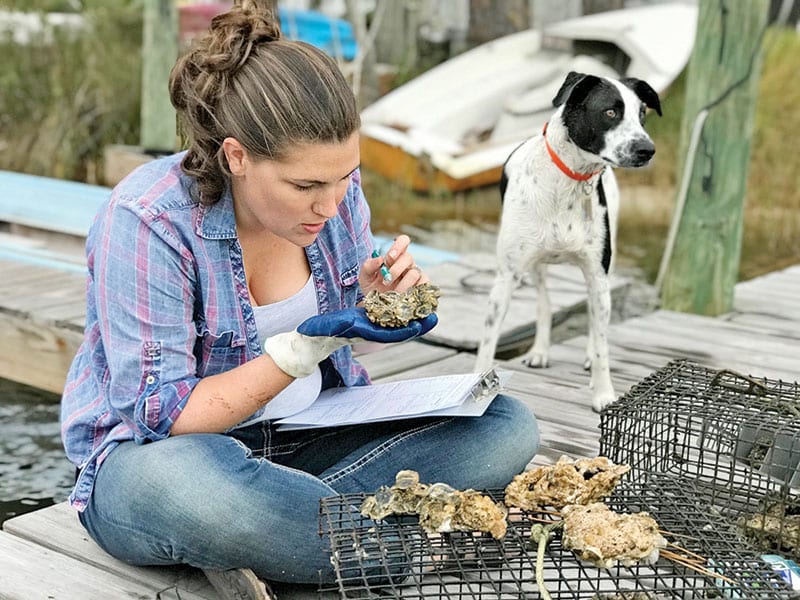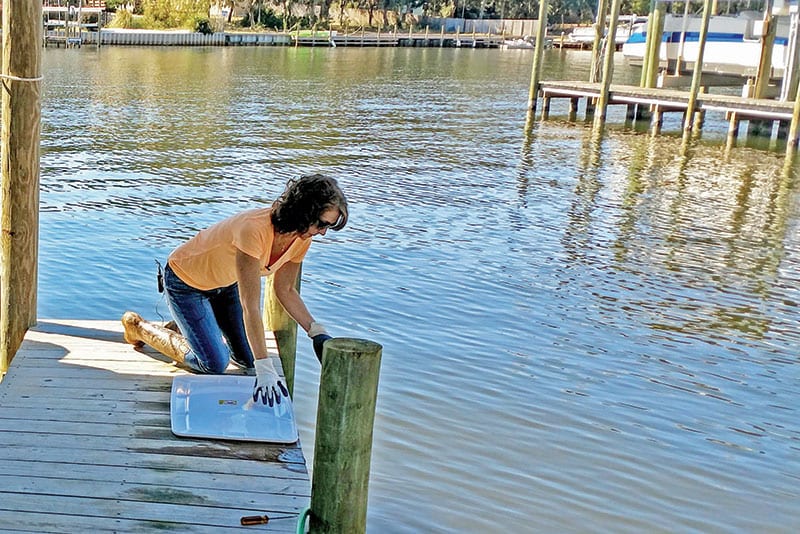Jennifer McPeak, a Choctawhatchee Basin Alliance (CBA) Oyster Gardener volunteer, showed me to her dock on a serene Destin bayou. The fall sunshine and clear blue sky had combined to create a beautiful morning, and mullet splashed in the shallows while a Great Blue Heron stalked prey among the reeds nearby. Kneeling carefully against the wooden boards, she put on gloves to hoist her cage up out of the water, gently placing the wire on a white plastic rectangle.
Even before she removed the oysters, life spilled out of the cage. Oyster toadfish – predators of her juvenile oysters – wiggled back into the water, while dozens of crabs hid from the light or made a bee-line towards the oyster clusters themselves. McPeak carefully returned the critters to the bayou, then turned to spray her oysters down with a hose.

McPeak is a member of the 20-volunteer Oyster Gardening team. Each gardener not only receives an oyster cage, he or she also is given spat (juvenile oysters), measuring equipment, and water quality monitoring instruments as part of the CBA program. As their oysters grow, gardeners are required to clean their cages once a week and collect monthly size, predator, mortality, and water data. By next spring, most of the oysters will have grown to two-inches in length, ready for transplant into a brand new oyster reef.
Ali Jean, Education Technician at CBA, helps run the gardener program. “Our economy depends on tourists, but Choctawhatchee Bay depends on local communities to care for her,” Jean explains, “Not only does oyster gardening positively affect the water quality in Choctawhatchee Bay, growing oysters for restoration purposes inspires our community members with a strong sense of pride as they are directly connected to our bay in a small, but impactful way.”
Oyster reefs provide essential ecosystem services within and around the Choctawhatchee Bay. Each oyster filters up to 50 gallons of water each day, and the reefs themselves provide habitat for marine species and reduce erosion along the shoreline. The oysters from the gardening program will provide a pulse of life when moved to brand new reef systems in April, right before spawning begins. As they release the next generation of spat, the oysters from this program will provide a water quality boost to our bay.
After rinsing off the oysters, McPeak turned them this way and that, impressed with the heavy clusters. “My favorite thing about living in this area is the gorgeous water and abundant wildlife,” she says, “By participating in the CBA Oyster Gardening Program, I feel I can make a small contribution to efforts to preserve and conserve the natural beauty that I hold dear.”
For more information about becoming an oyster gardener for CBA, check out their website at basinalliance.org or their Facebook page at facebook.com/basinalliance.
Erika Zambello
zambelle@nwfsc.edu
www.basinalliance.org

